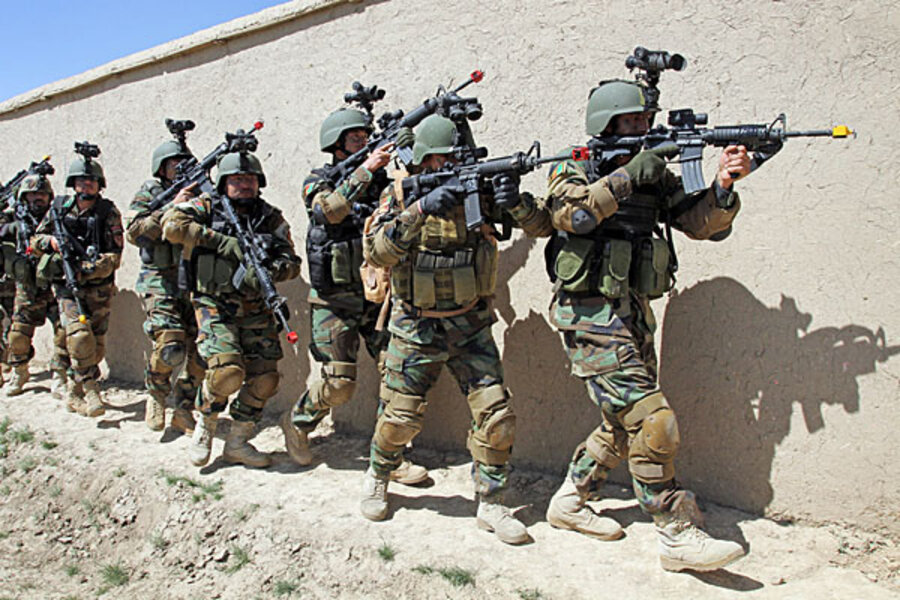Afghan commando kills special forces soldier: US training mission futile?
Loading...
| Washington
The latest killing of a US soldier at the hands of an Afghan counterpart – this time of a US Special Operations Forces soldier by a US-trained Afghan commando – raises anew concerns about America’s ability to build a credible Afghan security force before 2014, when US combat forces are scheduled to leave the country.
In total, so-called green-on-blue killings now account for 20 percent of the 84 NATO casualties in 2012.
The fatal shooting during a joint night raid Thursday marks the first killing of a US Special Forces operative by one of the elite, highly trained Afghan commandos, who are meant to be more carefully vetted than their conventional force counterparts. Largely as a result, the commandos have been widely praised by US forces for their competence.
Indeed, Afghan special forces units earlier this month were tapped to take over responsibility for a key aspect of US strategy going forward – namely, the controversial night raids that have polarized the Afghan community. US commanders have emphasized that these raids, in particular, are key to the US strategy in Afghanistan. Insurgents do not have night vision technology, after all, and are particularly vulnerable to coalition force operations that take place in the dead of night, they say.
In this latest case, US forces shot and killed the Afghan commando perpetrator. Another Afghan commando and an interpreter were killed in the crossfire. The incident occurred in the violent Kandahar Province in southern Afghanistan.
Previously, Gen. John Allen, commander of US and NATO forces in Afghanistan, has pointed to “the insider threat” facing US troops who train Afghan security forces. To combat it, Afghan government officials now put “counterintelligence operatives” inside their training programs for security forces, as well as “inside their recruiting centers and inside their ranks,” Allen said last month, “the idea being to spot and assess the potential emergence of an individual who could be an extremist or in fact a Taliban infiltrator.”
The Taliban claimed credit for the most recent shooting, as it does with most such “green on blue” shootings, US military officials say. “The Taliban of course takes credit for all of them, when in fact the majority are not ... a direct result of Taliban infiltration,” Allen hastened to add at the time.
That said, "it’s no secret that the Taliban has had as an objective for some period of time infiltrating the ranks of both the ANSF [Afghan National Security Forces] and those elements that support us directly [at] our camps,” he acknowledged. US forces have put extra US troops on duty to guard their fellow soldiers as they sleep in bases that US and Afghan forces share, he added.
US commanders tend to emphasize that incidents of “green on blue” killings, like the one this week, are aberrations and do not affect the overall mission on the ground. They note that the killings can be apolitical, too – simply the result of Afghans venting their anger in the way they long have.
“When we analyze the problem, it occurs for a number of reasons, and not as many as you would expect show any evidence of insurgent initiation or insurgent backing,” a senior NATO official told Reuters. “Quite often people resolve their personal problems by resorting to the use of a weapon. It’s more of a cultural thing here.”
Others stress that though the most recent incident may raise questions of trust, it should not reflect poorly on the training program itself.
"One individual cannot denigrate the capabilities of an entire force," says retired US Army Col. John Agoglia, who was director of the US military's Counterinsurgency Training Center in Kabul from 2008 to 2010. When the commando units came through the center, they were notable for being "extremely competent and well-led," adds Mr. Agoglia, now vice president for operations and government services at IDS International. "The fact that this is the first incident they've had means we need to not jump to conclusions."
Chairman of the Joint Chiefs of Staff Martin Dempsey, after a trip to the region this week, warned that in Afghanistan “setbacks are going to occur, because the enemies are as intent on achieving their objectives as we are on achieving our directives.”
Still, General Dempsey indicated that he saw reason for encouragement. “What I come away from Afghanistan with this time is a sense not just of how we’re building units and equipping individuals – or even, for that matter, what skills they’re acquiring. I came away with a real sense of the value system that they are really just beginning to embrace as a force with standards and values,” he said.
“That was new to me. I’ve seen a lot of stuff in Afghanistan, but that was new.”







